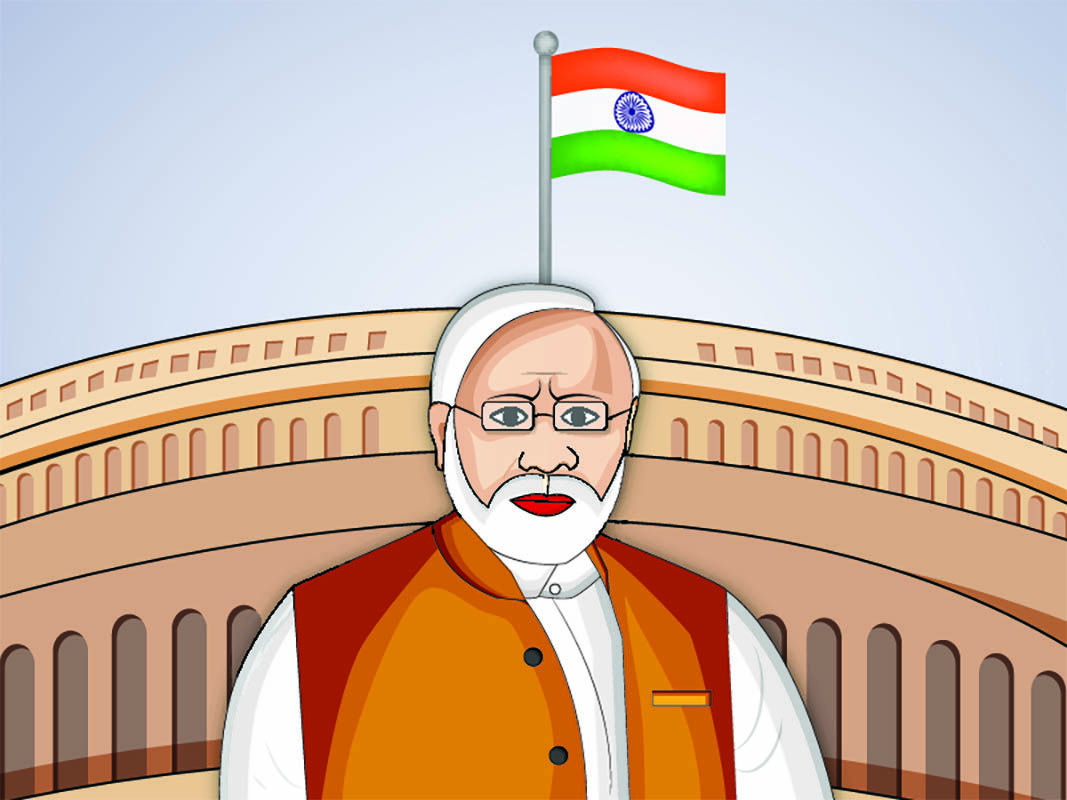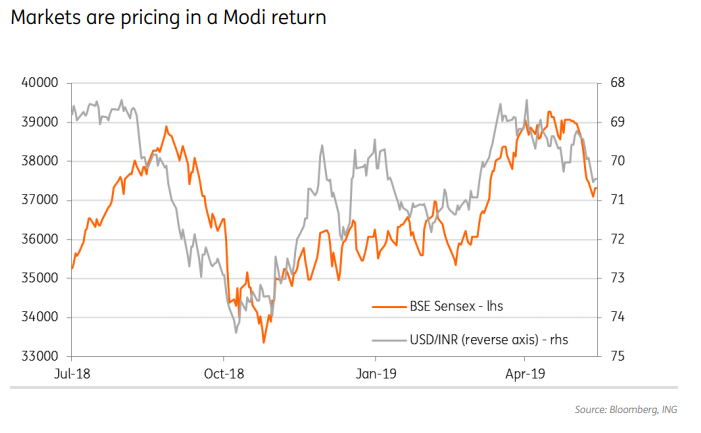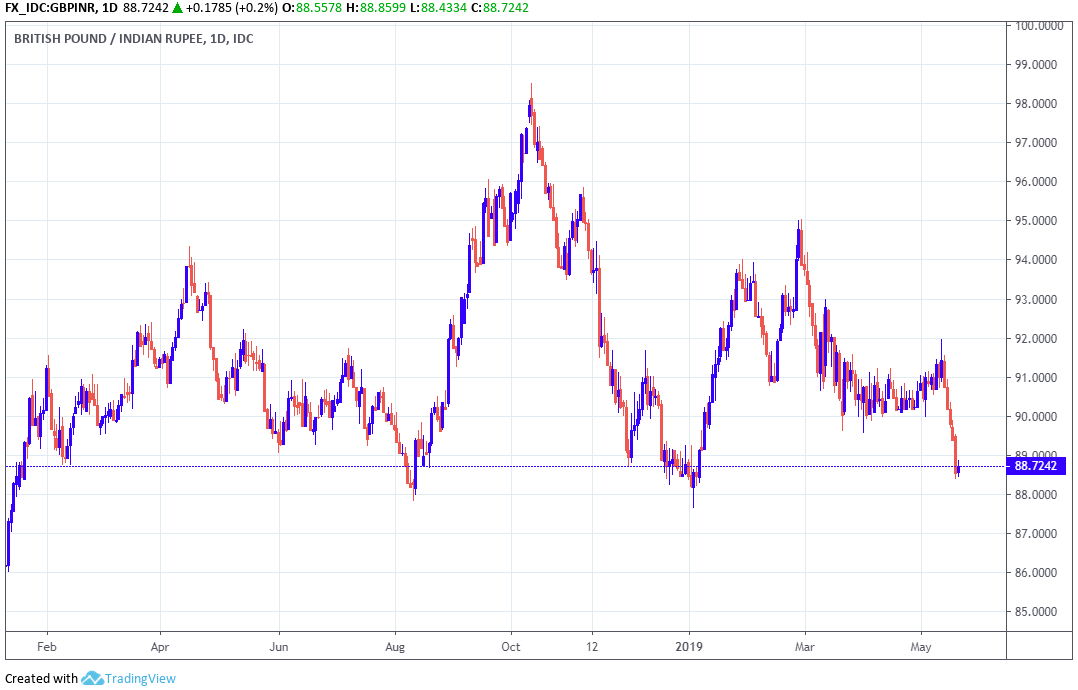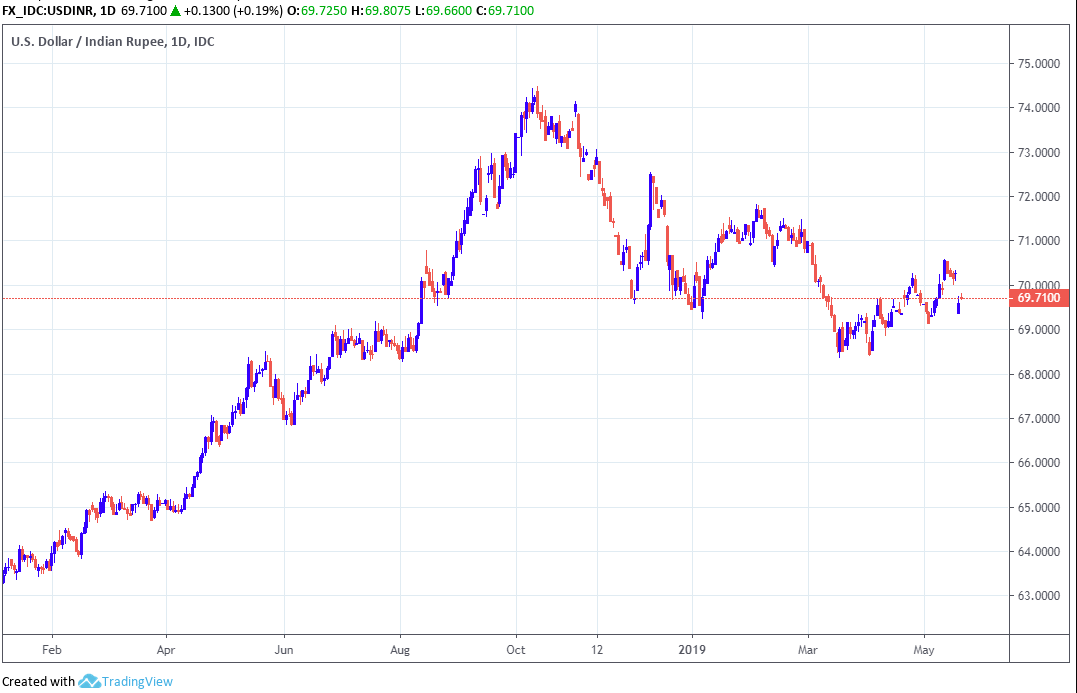The Indian Rupee's Election Gains are Seen Melting Away as Emerging Market Storm Brews
- Written by: James Skinner

Image © Adobe Stock
- INR gains at risk once election dust settles says ING Group.
- Modi majority may be narrow and 'trade war' threatens INR.
- U.S, Chinese slowdown to hit emerging market currencies.
The Rupee has gained sharply ever since polls began pointing toward victory for Prime Minister Narendra Modi and his Bharatiya Janata Party in this year's election, but analysts say gains for the Indian currency may not last for long.
Exit polls pointed this week to a clean sweep for Modi now voting in India's month-long election process has come to an end, further boosting the Rupee, although these polls are notoriously unreliable and the official result will not be available until Thursday.
"The Indian economy enjoyed solid growth of 7.5% per annum on average, during Modi’s five-year term, and low inflation of under 4% at least in the final year of his term," says Prakash Sakpal, an economist at ING Group. "But the misery caused by the sudden ban of high-value currency at the end of 2016 remains vivid in voter's minds."
Sakpal says the Rupee's outperformance of other emerging market currencies since February, as well as gains for the stock markets, are the result of expectations that Modi will emerge from the election victorious.

Above: Indian Rupee Vs U.S. Dollar, alongside Sensex index.
A victory for Modi and his BJP-led coalition would offer continuity to Indian businesses and households while providing government a mandate to continue with reforms that economists say are necessary.
These include lowering the budget deficit and a deleveraging programme aimed at constraining the increase in national debt. Also Modi's 'Make in India' initiative and various others aimed at addressing social ailments and inequalities.
But economists are concerned the Modi coalition might only just scrape a narrow majority, making for a fragile government, and that international factors could soon undermine the Rupee and its recent gains.
"It would probably pave the way for further structural reform in India. In our view, that would allow India to sustain rapid economic growth over the coming years," says Nikhil Sanghani at Capital Economics, of a Modi victory. "
Sanghani has also told Capital Economics' clients the Rupee's rally this week could be a bit premature due to the historical innacuracy of exit polls.

Above: Pound-to-Rupee rate shown at daily intervals.
Like Sakpal, Sanghani says the Modi agenda will be positive for the Indian economy in the long-term but he warns that pre-election giveaways, such as higher crop subsidies for farmers, will need to be recouped following the vote.
This, in the name of balancing the nation books, would risk slowing the pace of Indian economic growth at a time when the global economy is widely expected to weaken during the quarters and years ahead.
"Equities have been relatively insulated from the latest escalation in the US-China trade war and worries over the domestic outlook in China, given that the Indian economy is not closely linked in regional supply chains," Sanghani notes.
The U.S.-China tariff fight now risks becoming an all-out economic conflict because the White House is no longer relying on tariffs alone in order to pressure the Chinese into agreeing a deal that ends the country's "unfair trading practices" and alleged theft of intellectual property from foreign firms.
President Trump has placed China's Huawei, which is a national champion in the field of telecoms and related equipment, on its 'entity list'. This is a type of trade blacklist that could prevent U.S. and allied firms from supplying Huawei with parts and from using its products in their own goods.

Above: USD/INR rate shown at daily intervals.
"We think that global equities in general will slump this year as growth in the US as well as China underwhelms. In that environment, investors would probably retreat from EM currencies, so we suspect that the rupee will fall sharply against the US dollar too," Sanghani warns.
President Donald Trump's has raised from 10% to 25% the tariff levied on around $200 bn of annual imports from China, prompting a retaliation in relation to $60 bn of Chinese imports from the U.S.
Trump has also set the ball rolling on a process that could see a 25% tariff imposed on China's remaining $300 bn of exports to the U.S. and rhetoric from both governments has been increasingly hostile of late.
Fears are that in a world where the global economy is under threat from a serious and protracted U.S.-China trade conflict, the Dollar will strengthen and vulnerable emerging market currencies including the Rupee will be sold by investors.
ING's Sakpal also shares a pessimistic outlook for the Rupee over the short-term. He forecasts the USD/INR rate will trade within a tight range around the 0.71 level, which is not far from the record high seen in 2018, for the foreseeable future.
"The currency market has so far vindicated our forecast of the INR weakening past 70 against the USD. We see the pair trading in a tight range around 71 until the election dust settles," Sakpal writes, to clients.
Time to move your money? Get 3-5% more currency than your bank would offer by using the services of foreign exchange specialists at RationalFX. A specialist broker can deliver you an exchange rate closer to the real market rate, thereby saving you substantial quantities of currency. Find out more here.
* Advertisement
